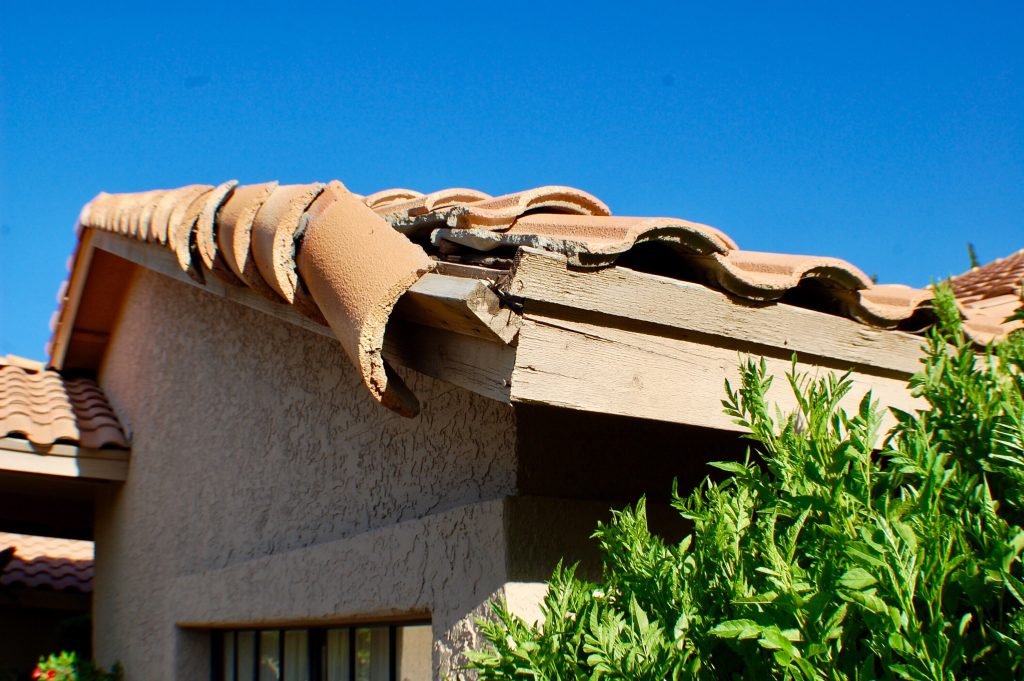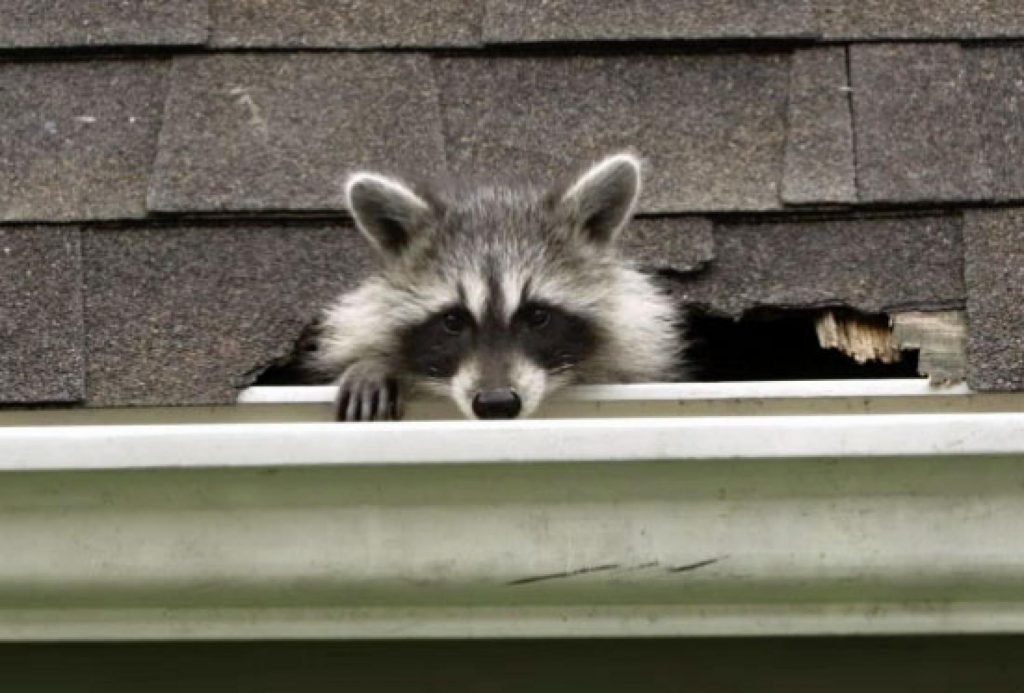Wildlife Caused Roofing Damage Repair

Nuisance wildlife damage roofs, requiring homeowners to perform repairs before water damage can occur. Often when wild animals are found in the attic, they created some sort of roof damage to gain access to the home’s interior. Most people aren’t aware of how nearby birds, bats, squirrels, raccoons, and rodents might affect their roofs. All of these, however, have the potential to cause more harm than you know. Understanding how these nuisance species create roofing damage will aid in repairs and preventing roof damage in the future. Contact Animals Happen at 833-633-1120, to learn more about wildlife roof damage repair.
How Can Animals Damage A Roof?
Your home’s roof is designed to protect it from Mother Nature’s harsh weather conditions. Roofs aren’t designed to withstand continual contact with animals or their attempts to gain access to the attic space through the roof.
Squirrels, raccoons, and opossums, for example, will use their paws and teeth to make holes in the roof’s weak spots. Whether or not the animals get inside your property, the damage will be prone to roof leaks, which will lead to mold, rotting wood, and a roof’s lifespan being decreased.
The Destructive Habits Of Birds
Large amounts of bird droppings can be incredibly detrimental to roofing materials, in addition to being filthy. The concentration of uric acid in animal droppings is high. It could corrode roof tar and tar paper, as well as cause roof shingles to disintegrate.
We advocate for homeowners to hire a professional instead of cleaning their roof because it can be risky. Bird Control experts can employ devices that will keep nuisance birds off of the roof for good. They can also repair any of the damage that has resulted from the current bird problem.
Raccoon Roofing Damage
 There are several ways for a raccoon to get access to your roof. These nuisance animals can burrow, claw, and chew their way right through your roofing materials, but most find a small hole and use it to gain access to your home.
There are several ways for a raccoon to get access to your roof. These nuisance animals can burrow, claw, and chew their way right through your roofing materials, but most find a small hole and use it to gain access to your home.
Water damage can degrade plywood sheathing, putting your roof’s integrity at risk. Raccoons can tear through water-damaged wood in a matter of minutes.
Attic and air vents can be found on top of any attic. Plastic vents are not constructed to prevent wildlife entry. Raccoons will use their sharp teeth to tear apart any plastic vents on your roof. Wildlife control companies will install metal vents that are strong enough to deter a curious raccoon.
Debris on your roof is a frequent source of roofing damage, and it might entice a raccoon to dig a hole in your roof. Water can pool and seep between your tiles as leaves, branches, and other debris gather on your roof. If the critter gets inside your home, raccoon droppings will begin to produce nasty odors and spread disease. 1Go To portal.ct.gov -“Raccoon Nuisance Problem”
Roof Damaged From Squirrels
Squirrels can eat through your roof decking and rip up your shingles. They could rip holes in your roof’s soffit or fascia, damage your gutters, and then break into your house and cause havoc. When they get into your attic, they may chew up electrical wiring, destroy your insulation, and contaminate the items you thought were put away for safekeeping.
Animals or insects might enter your home in a variety of ways. If there are any breaches in your soffit or fascia, they may be able to get in. If you have an opening in your siding, they can also get in. Animal entry also occurs through ridge vents and uncapped/exposed chimneys. 2Go To Source maine.gov -“Evicting Animals From Buildings”
Opossum Damage To A Home’s Roof
Because opossums typically enter a structure via climbing, you may notice extensive damage to the exterior of your home. Opossum damage frequently occurs on your roof in the form of damaged shingles and pulled soffit. Opossums may also damage eaves, siding, and gutter systems.
If you have opossums in your home or another structure on your property, you should be able to see them right away. Because these animals are louder and less nocturnal than some nuisance wildlife, they are frequently highly apparent even during the day.
Roofing Repair Process
- Initial Property & Roof Inspection: The first step is a damage and infestation assessment. This is a vital step because it tells the wildlife technician how much damage has occurred and if there are animals in the attic that need to be removed. Using this information, a damage repair/animal removal plan is created specifically for your home.
- Wildlife Removal Services: This step may not be necessary if the attic is free of nuisance wildlife. If wild animals are present, they will be humanely removed following local laws and regulations.
- Roof Damage Repair: Roofing repair professionals will begin by sealing all entry points created by the animals. This involves repairing shingles, soffits, eaves, vents, and anything else that might have been damaged. Structural materials such as wood support beams may need to be replaced due to water damage.
- Attic Cleanup: If the animals have found a way into the attic or vents, it’s almost guaranteed that they have left droppings and urine within the infested space. The animal waste will need to be cleaned to prevent the spread of harmful bacteria.
- Final Walkthrough & Wildlife Proofing: Once the repairs have been performed, a final inspection is done to ensure nothing has been passed over. Wildlife-proofing materials such as steel vents can be installed to protect your roof against animals in the future.
Has Your Roof Been Damaged By Wild Animals?
Wild animals searching for access to your home may be attracted to the soffits, eaves, and fascias on your home’s roof. Squirrels, bats, raccoons, and birds are drawn to worn soffits because of the soft, rotting wood, which allows them to chew and peck to build nests and find food readily. Wildlife control experts provide the equipment, supplies, and experience needed to repair your damaged soffit and keep animals out of your home. If you suspect nuisance wildlife has damaged your roof, call Animals Happen at 833-633-1120 for animal damage roof repair or to prevent any further damage.
Sources:
- “Problems with Raccoons.” CT.Gov – Connecticut’s Official State Website, CONNECTICUT’S OFFICIAL STATE WEBSITE, 1 Apr. 2020, portal.ct.gov/DEEP/Wildlife/Nuisance-Wildlife/Problems-with-Raccoons.
- Hodge, Guy. “Evicting Animals From Buildings: How to Avoid or Resolve a Wildlife Conflict: Living with Wildlife: Wildlife: Fish & Wildlife: Maine Dept of Inland Fisheries and Wildlife.” Maine.Gov, www.maine.gov/ifw/fish-wildlife/wildlife/living-with-wildlife/avoid-resolve-conflict/evicting-animals.html. Accessed 28 July 2021.
- “Roofing Materials to Protect You From the Elements”. HuffPost. Retrieved 2018-11-07.
C.M.Harris,Dictionary of Architecture & Construction - “How Roofing Materials Work”. HowStuffWorks. 2009-01-09. Retrieved 2018-08-14.
- “Roofing Contractor”. labormarketinfo.edd.ca.gov. State of California. Retrieved 18 February 2015.
